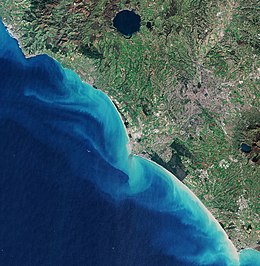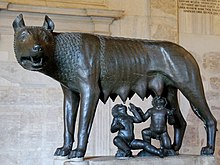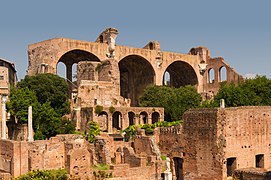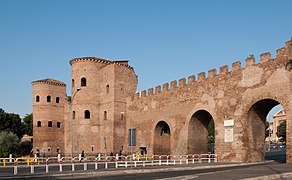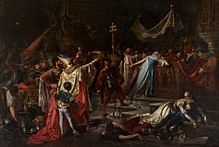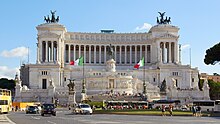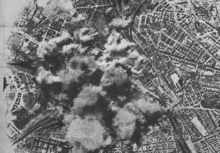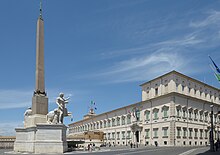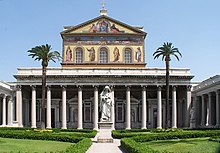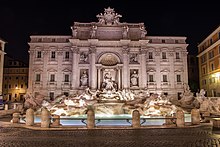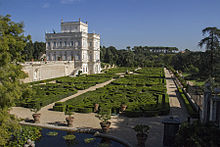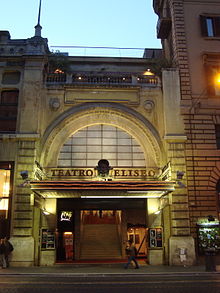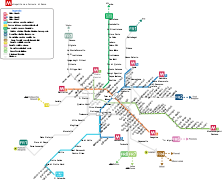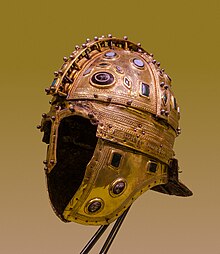Rome
| Roma Rome |
||
|---|---|---|

|
|
|
| Country | Italy | |
| region | Lazio | |
| Metropolitan city | Rome (RM) | |
| Coordinates | 41 ° 53 ′ N , 12 ° 29 ′ E | |
| height | 37 m slm | |
| surface | 1,287.36 km² | |
| Residents | 2,837,332 (Dec 31, 2019) | |
| Factions | → Urban division of Rome | |
| Post Code | 00100 (general) and 00121-00199 | |
| prefix | + 39-06 | |
| ISTAT number | 058091 | |
| Popular name | Romani | |
| Patron saint | Peter and Paul | |
| Website | www.comune.roma.it | |
 Left: Colosseum , Pantheon and Trevi Fountain . Right: St. Peter's Basilica and Castel Sant'Angelo . Below: Tiber and Angel Bridge . |
||
Rome ( Latin Rōma ; Italian Roma [ ˈroːma ], officially Roma Capitale ) is the capital of Italy , capital of the Lazio region and the historical capital of the Roman Empire and the Papal States . The city is located in the middle of the Italian peninsula on the river Tiber . With around three million inhabitants in the urban area and around four million inhabitants in the agglomeration , it is the largest city in Italy and the third largest in the European Union . In addition, Rome, with a municipal area of 1287.36 km², is also the largest city in the country in terms of area.
Rome was first discovered in the 1st century BC. Called the Eternal City by the poet Tibullus . This designation, originally an antonomasia , became a name of honor for the city because of its importance in its three millennia spanning history. According to the legend practiced by the Romans , Rome was founded in 753 BC. Founded in BC, but is probably older. After the influence of the Etruscans had been shaken off , Rome established itself as an independent city-state, which over the centuries was able to take possession of Italy and then most of the ancient Mediterranean . The Latin , spoken local dialect and Italian language, which originated in the city of Rome , has spread through the Roman expansion over all of Italy, especially in the south-western Mediterranean region, and has fundamentally influenced the local languages there, which has led to the emergence of the Romance languages . Classical Latin has been able to hold its own as the lingua franca of science, philosophy, art, theology, politics and diplomacy into modern times. The ancient Roman city law has left a significant influence on European legal systems to this day.
Even before the fall of the Western Roman Empire , Rome lost its population and political influence, but was a center of the Christian religion through the Middle Ages and modern times and is still one of the centers of the West today . After the conquest by Italian troops, Rome has again been part of a unified Italy since 1871, right up to the Alps , as it had been for centuries in antiquity: “ All roads lead to Rome ”. Chamber of Deputies , Senate , President , Government and the Constitutional Court of the Italian Republic have their seat in Rome, also today the administrative seat of the Lazio region and the metropolitan city of Rome-capital , which will replace the previous province of Rome in 2015. Rome is divided into 15 municipi .
Roma capitale ("Rome capital") has a special status as a municipality. The state ( or ) of the Vatican City is located within the city limits . It is an independent landlocked state and the seat of the Pope , i.e. the Bishop of Rome. He is the head of the Roman Catholic Church and the Holy See ; the latter forms an independent subject of international law, with the result that the city of Rome has been home to two of three non-state subjects of international law since 1834 (establishment of the seat of the Order of Malta ) . The UN sub-organizations FAO , IFAD and WFP are also based there.
Rome is extraordinarily rich in important buildings and museums and a destination for numerous tourists. The old town of Rome, St. Peter's Basilica and the Vatican City were declared World Heritage Sites by UNESCO in 1980 .
Surname
etymology

The oldest Latin evidence of the name can be found on the Cista Ficoroni from the late 4th century BC. But already in the indirect Greek tradition of the 5th and 4th centuries BC, preserved from Dionysius of Halicarnassus . The name occurs in the form Ῥώμη Rhṓmē , as in Hellanikos of Lesbos , Antiochus of Syracuse and Damastes of Sigeion . While in Old High German, in addition to Rōma, there was also the form Rūma * as the name of the city, the Middle High German language level mostly used Rōme or Rome, but was also familiar with the abbreviation to Rōm and Rome. The etymology of the word Roma itself is unclear, but different theories have been discussed since ancient times.
In addition to mostly purely mythical explanations, which brought the name in connection with numerous people called Romus or Roma and linked the founding saga with Greek mythology , the story of Romulus and Remus was in the foreground in the ancient explanation of the name . The story, first recorded by Diocles of Peparethos , which was considered particularly credible and documented, at least for Plutarch , traced the name back to Romulus, the founder of the Roma quadrata , but woven the ficus Ruminalis , a fig tree that would provide shade on the later forum . The latter's name was derived either from Romulus or from the old Latin word ruma for the suckling breast, which fits into the story of the twins suckled by the she-wolf. "Rationalistic" representations combined the name of the city, which the Pelasgians are said to have given to the place they founded in mythical prehistoric times, with the Greek word ῥώμη 'power' , 'strength'. If the founding of a Greek city in Rome was rejected, it was pointed out that the city once bore the name Valentia (from Latin valentia 'strength' , 'strength'), which changed to griechμη under Greek influence .
Modern derivations of the name follow different approaches. The most widespread is the connection with the Indo-European root * .sreṷ- 'flow', which for Roma means 'settlement on the river'. The Latin word rūma 'female breast' and rūmon as the old name of the Tiber, Massimo Pittau repeatedly placed in this context already constructed in ancient literature.
Equally widespread is the derivation from an Etruscan gentile name Ruma . Following a suggestion made by the linguist Wilhelm Schulze in 1904, the name would designate the ' settlement of the Tuscan ruma '. This approach is particularly popular in Italian research, but is also favored by scientists from other countries. The objection was made that the Etruscan name of the city was * Ruma , but Latin words with Etruscan roots always kept their / u / sound. However, since Etruscan originally did not know a sound / o / that was only released after an inner-Etruscan sound shift of the 6th / 5th centuries . Century BC BC and thus encountered centuries after the founding of a city or settlement, one would have to expect the city name in Latin Ruma as well . For this reason, a derivation of the city name from Etruscan is unlikely.
In addition, there are numerous approaches that mostly did not trigger any further discussion and were not pursued further.
The Eternal City"
After the poet Tibullus had already found the description "the eternal city" for Rome in the late republic , this idea was further developed. For example by the Roman poet Virgil (70–19 BC), who wrote the Aeneid based on Homer's example , which is a narrative of the prehistory and importance of Rome. At that time this book became a textbook in Roman schools and is considered the national epic of the Romans. In this work, the god Jupiter prophesies the eternity of Rome, to which no spatial or temporal limits are set.
Even at the end of the imperial era (middle or end of the 4th century AD), some authors speak of the never-ending Rome. The officer and historian Ammianus Marcellinus (around 333 - after 391) justifies the eternity of Rome in his analogy of life with the fact that virtus 'strength', 'virtue' and fortuna 'luck' would have concluded a covenant of eternal peace when they were founded, which guarantees that Rome will last as long as people live. The lawyer and high official Aurelius Prudentius Clemens (348 – after 405) also compared the idea of Eternal Rome with the idea of Christian Rome. According to Prudentius, the Roman Empire united the multitude of nations and, with its peace, paved the way for Christians. Furthermore, Rome was not deprived of its strength or aged, but could still take up arms when wars called.
geography
Expansion of the urban area
Rome is located in the middle of Italy on the Tiber , not far from the Tyrrhenian Sea , an average of 37 meters above sea level . The Tiber flows south through the city in several turns. In the north, the Aniene flows into it in the Parioli district . The wider area is the Campagna Romana or Campagna for short . In the east of Rome are the Abruzzo Mountains , in the northeast the Sabine Mountains and in the southeast the Alban Mountains .
The metropolitan city of Rome borders the province of Viterbo and the province of Rieti to the north, the province of L'Aquila in the Abruzzo region to the east and the province of Frosinone and the province of Latina to the south .
City structure
Rome is divided into four urban districts, 15 municipalities and 155 urban areas.
The 15 (up to March 11, 2013 there were 19) municipalities are: (1) Municipio I (with the old town Centro Storico , Prati and other old districts), (2) Parioli and Nomentano - San Lorenzo , (3) Monte Sacro , (4) Tiburtina , (5) Prenestino and Centocelle , (6) delle Torri , (7) San Giovanni and Cinecittà , (8) Appia Antica , (9) EUR , (10) Ostia , (11) Arvalia Portuense , ( 12) Monte Verde , (13) Aurelia , (14) Monte Mario and (15) Cassia Flaminia .
The old town (Municipio 1) is divided into 22 Rioni ( districts ), some of which go back to antiquity. They no longer have any administrative significance.
The old Municipio 14 was amalgamated in 1992 and is now the independent city of Fiumicino .
The 16 × 17 m plaster model Plastico di Roma Antica in the Museo della Civiltà Romana on a scale of 1: 250 also provides a realistic overview of the historic city .
climate
The climate of Rome is typically Mediterranean , dry in summer (arid) and humid in winter (humid). The drought in summer is due to the shift in the subtropical high pressure belt; In this high pressure zone the air sinks and clouds are dissolved. The subtropical high pressure belt shifts southward in winter, and a moist extra-tropical westerly wind zone covers the Mediterranean area from the north .
| Rome | ||||||||||||||||||||||||||||||||||||||||||||||||
|---|---|---|---|---|---|---|---|---|---|---|---|---|---|---|---|---|---|---|---|---|---|---|---|---|---|---|---|---|---|---|---|---|---|---|---|---|---|---|---|---|---|---|---|---|---|---|---|---|
| Climate diagram | ||||||||||||||||||||||||||||||||||||||||||||||||
| ||||||||||||||||||||||||||||||||||||||||||||||||
|
Climate table Rome
Source: wetter.de; Air humidity, water temperature: wetterkontor.de
|
|||||||||||||||||||||||||||||||||||||||||||||||||||||||||||||||||||||||||||||||||||||||||||||||||||||||||||||||||||||||||||||||||||||||||||||||||||||||||||||||||||||||||||||||||||||||||||||||||||
history
Antiquity
founding
According to the founding legend , Rome was founded on April 21, 753 BC. Founded by Romulus . Romulus later killed his twin brother Remus when he was amused by the city wall built by Romulus. According to legend, the twins were the children of the god Mars and the vestal virgin Rhea Silvia . They were released on the Tiber , suckled by a she-wolf and then found and raised by the shepherd Faustulus on the Velabrum below the Palatine .
The Roman astrologer Lucius Tarrutius , a friend of the scholar Marcus Terentius Varro , calculated a deviation from the known date of foundation as October 4, 754 BC. Between the 2nd and 3rd hour of the day as the time of foundation, whereby he assumed a natal chart of Romulus.
Excavations on the Palatine have revealed remains of settlements from around 1000 BC; probably some Latin and Sabine villages then became around 800 BC. BC (perhaps by the Etruscans) united to one city or grew together.
Royal times and republic

According to historians, the consolidation of individual settlements into a community could actually have occurred around the legendary founding date. The proverbial seven hills of Rome are: Palatine , Aventine , Capitol , Quirinal , Viminal , Esquiline and Caelius . Today the urban area also extends over the famous hills Gianicolo , Vaticano and Pincio .
At the beginning of its history, Rome was a kingdom ; as the first of the - largely legendary - successors to Romulus, Titus names Livius Numa Pompilius . After the expulsion of the last Etruscan king Tarquinius Superbus - allegedly in 509 BC. BC - Rome became a republic - although this was actually only around 475 BC. Happened. The following period was marked by class struggles between the rightsless, if free plebeians and the aristocratic patricians . Rome now began to annex the surrounding areas.
Although Rome was founded in 390 BC. BC could hardly prevent an invasion of the Celts , the city expanded constantly. To protect against further attacks, the Servian Wall was built (see the figure The seven hills of Rome ). 312 BC The first aqueduct and the Via Appia followed . The finally successful Punic Wars (264–146 BC) against the North African Carthage , which controlled the western Mediterranean , also contributed to the expansion of Rome .
After the brothers Tiberius and Gaius Sempronius Gracchus , who had tried to implement land reforms as tribunes, were murdered, a phase of instability occurred that culminated in civil wars . Gaius Iulius Caesar pushed through a number of reforms as dictator , but was defeated in 44 BC. Murdered BC. At this point in time, the Roman Forum had already reached a building density that made it necessary to expand the area. For this reason Caesar had started building the Forum Iulium .
Imperial times
In the 1st century AD, Rome was probably already a city of millions and both geographical and political center of the Roman Empire . It had a functioning fresh water and sewage system, an extensive road network and functioning civil protection units ( vigiles ), which served as fire brigades with police powers. The expansion of Rome, which had been accelerated especially under Caesar's heir Augustus , the first emperor , was temporarily thrown back by a great fire in Rome under Nero in 64.
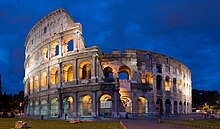
Under the rule of the Flavian dynasty (69–96 AD) extensive construction work began, which was financed by the emperors. These new public structures include some of the most famous monuments such as the Colosseum and part of the Imperial Forums . The last of these forums was completed at the beginning of the 2nd century under Emperor Trajan . This time is often seen as the high point of the Roman Empire. Large thermal baths , such as those built by Caracalla and Diocletian in the 3rd century , which even included libraries, had become an integral part of urban Roman life. Obsessed with the idea of surpassing their predecessors, the emperors built ever larger structures, such as the Maxentius basilica . This is sometimes seen as an indication of the beginning of the decline of the empire, but above all it shows that Rome was still the most important stage for sovereign self-expression until the early 4th century. Furthermore, the Aurelian Wall was built in the late 3rd century , as the city had long since grown beyond the limits of the Servian Wall .
Maxentius Basilica in the Roman Forum
Late antiquity
At the beginning of late antiquity around the year 300 Rome probably reached its largest population; the most common assumptions are around an estimated 1.2 million inhabitants. The city soon lost its political importance, however, as the various emperors preferred other residences (including Ravenna , Constantinople , Milan , Trier , Thessaloniki , Split ). Constantinople, in particular, became a rival in the 4th century.
In the 5th century the western half of the empire got into a vicious circle of civil wars and attacks from outside, which also affected the city of Rome. A beacon was the sack of Rome in 410 by mutinous Gothic mercenaries , and again in 455 by the vandals . The civil war between Anthemius and Ricimer was fought primarily in Rome in 472 and also badly affected the city. More importantly, since 429 they lost control of North Africa, on whose grain deliveries the city depended. From then on the population fell rapidly, although emperors like Valentinian III. or Anthemius resided on the Tiber for a longer period of time.
After the end of the Western Roman Empire in 476, large urban institutions such as the Diocletian's Baths and the Colosseum continued to be maintained; Despite the falling population, ancient life continued. The Senate also continued to exist. Prokopios stated that the buildings of the city were maintained during the rule of the Ostrogoths . Theodoric the Great had animal hunts and chariot races held. Around 530, around 100,000 people were still living in Rome. The civilizational catastrophe came with the Gothic Wars and the reconquest policy of the Eastern Roman emperor Justinian pursued in this context . The long acts of war led to the final destruction of almost all Roman aqueducts (537), to the extensive extinction of the class of senators who had preserved the ancient heritage, and to several years of urban life being suspended due to Eastern Roman-Gothic siege battles. As a result, the population fell to a few tens of thousands. In 550 the last chariot races took place in the Circus Maximus .
Italy formally belonged to the Eastern Roman Empire again since 554 , but the regulatory functions in Rome were exercised more and more by the Popes during the times of the " Great Migration " . The Eastern Roman-Byzantine exarch did not reside on the Tiber, but in Ravenna; Rome sank to the status of a Byzantine provincial city and now also lost its symbolic meaning; only the papacy provided a remnant of glamor and relevance. The last late antique building in the heavily depopulated city was the Phocas column, erected in 608 . Soon after, the Roman Forum seems to have lost its importance for the city for good; the ancient monuments fell into disrepair.
middle Ages
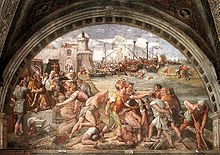
Since Pippin , Rome gained new importance as the capital of the Papal States ( Patrimonium Petri ) and as the most important place of pilgrimage for Christianity next to Jerusalem and Santiago de Compostela . New splendor came to the city in the year 800, when Charlemagne was given by Pope Leo III. was crowned Emperor of the Holy Roman Empire . Between 843 and 849 three attempts at conquest by Muslim Arabs failed, but the half of the city on the right bank of the Tiber was plundered in 846.
Between the 8th and 11th centuries, further sieges, attacks and looting by Lombards , Saracens and Normans followed . Around 800 the population was just 20,000. Due to the rapid population decline, a good three quarters of the urban area enclosed by the Aurelian Wall became orphaned , which in the following time lay fallow and overgrown or was later used for agriculture. The densely populated districts concentrated on the surrounding banks of the Tiber, on the Marsfeld and on the Borgo between St. Peter's Church and Castel Sant'Angelo . In the area within the Aurelian Wall, this established the special contrast between the areas abitato (densely populated banks of the Tiber, Marsfeld, Borgo) and disabitato (fallow, uninhabited landscape areas), which was to characterize Rome from the 11th to the 19th century. The ancient city centers, the Roman Forum, the Capitol, the Imperial Forums, the Colosseum, etc. were all in the uninhabited disabitato . The new centers of Rome now formed the Borgo with Alt-St. Peter and the Campo de 'Fiori . In the Middle Ages, there were at times separate small settlements in the disabitato , which had formed around the large churches of Rome outside the abitato , such as the Lateran Basilica or the Church of Santa Maria Maggiore .
The tomb of the apostle Paul, who was executed after the fire of Rome under Nero in 64, as well as numerous other relics promised the pilgrims extraordinary graces and indulgences in the Holy Years from 1300 onwards, presumed by the Catholic Church to be in Rome . In particular, the assumption that Simon Peter was executed together with Paul and buried in Rome contributed to this. This assumption is extremely controversial among historians to this day. The pilgrims were a mainstay of the commune , which had been trying to self-govern since the 12th century. A first revival of the commune in the dispute with the papacy with the participation of the church reformer Arnold von Brescia was violently interrupted with the coronation of Frederick Barbarossa in 1155.
Renaissance
Rome's flourishing during the Renaissance was interrupted in 1527 by the Sacco di Roma 'Sack of Rome' when Charles V's mercenary troops sacked and ravaged Rome.
Many important buildings were built in Christian times, for example the so-called four patriarchal basilicas Saint Paul Outside the Walls above the grave of St. Paul the Apostle from the 4th century, the Lateran basilica , also from the 4th century, modified in Baroque style by Francesco Borromini , and Santa Maria Maggiore from the 5th century and above all St. Peter's Basilica , which in its current form dates from the Renaissance and Baroque .
In the Renaissance and Baroque periods, the city found a new character, which is mainly determined by churches , but also by new streets with lines of sight to palaces and squares with fountains and obelisks . Rome has remained in this state to this day, which is why the Roman old town, along with the Vatican, is one of the two world cultural heritage sites in the city of Rome.
Capital of Italy
In 1849 France stationed troops in the Papal States. In the summer of 1870 - the session of the First Vatican Council was just off - France withdrew it from Rome after declaring war on Prussia . On September 20, 1870, Bersaglieri broke through the Porta Pia and invaded Rome, thus completing the unification of Italy . The Papal State was annexed to Italy by decree on October 6, 1870.
By a law signed by King Victor Emmanuel II on February 3, 1871, Rome was declared the capital of the Italian national state that was established as a kingdom in the course of the Risorgimento ; Turin and, from 1865, Florence had previously played this role. In the summer of 1871 the government moved from Florence to Rome. The Pope, deprived of his secular power, and large parts of the Catholic population were hostile to this new state for decades. Towards the end of the 19th century, a strong influx from the rural areas of Italy began, so that Rome for the first time since ancient times grew beyond the city limits of the Aurelian Wall. In 1922, the fascists under Benito Mussolini took power in Italy with the march on Rome . In the fascist dictatorship , the differences between state and church were ended by the Lateran Treaty with the Holy See in 1929 and the independent state of Vatican City was established. In addition, antiquities were restored during this period in the course of the propagandistic glorification of Roman antiquity, the monumental national monument Monumento Vittorio Emanuele II was completed in 1927, new buildings and visual axes were created in the historic old town and the EUR ( Esposizione Universale di Roma ) district was built. The most famous of the EUR's often futuristic -looking new buildings is the Palazzo della Civiltà Italiana (also Palazzo del Lavoro ). Unlike in Germany, for example, fascist inscriptions and symbols were almost never removed, so that the architectural and propaganda representation of fascism can still be seen in the cityscape.
Second World War
On July 19, 1943, the Allies bombed Rome for the first time. A major target for the United States Air Force's 390 bombers was Tiburtina Station . Above all, however, the working-class quarters of the San Lorenzo district and the church of San Lorenzo fuori le mura were destroyed . Immediately after the armistice in Italy on September 8, 1943, the German occupation of Rome began, according to the guidelines laid down in the Axis case, with several measures of repression against the civilian population, including the raid on the Jewish population of Rome on October 16, 1943, in which over 1000 residents of the Jewish population Ghettos were deported to Auschwitz . One day after the assassination attempt by communist partisans in Via Rasella , Herbert Kappler had the massacre carried out in the Ardeatine Caves on March 24, 1944 , in which 335 Italian civilians were killed. Pope Pius XII also waited during the following air raids and when Allied troops approached the city in May 1944 . in Rome. In order to prevent a second Monte Cassino or even Stalingrad , he tried to get Rome to be an “ open city ” on all sides . On the German side, the plan received support inter alia. by Ernst von Weizsäcker and SS-General Karl Wolff . The German field marshal Albert Kesselring declared Rome an open city at the beginning of June 1944 and withdrew all troops except for a rearguard. Allied troops marched into Rome on June 4, 1944.
After the Second World War , King Umberto II left the country in 1946 and Italy became a republic .
Rome as a modern city
In the post-war decades Italy experienced an unprecedented economic boom ( miracolo economico ) and a strong rural exodus : Millions of people from southern Italy and the mountain regions of Abruzzo poured into the capital. In order to eliminate the barracks settlements of the immediate post-war period, large housing estates arose from 1962, as in all major Italian cities , which in Rome were often unplanned and placed in the Roman Campagna without a building permit and subsequently legalized for a fee. At the same time, residential areas for the rising middle class emerged in the 1960s and 1970s. By 1980 the city's population had doubled.
In 1955 the first line of the metro Metropolitana di Roma was opened and in 1960 the XVII. Summer Olympics take place.
The so-called borgate abusive 'abusive suburbs' often offered no infrastructure, no green spaces, no schools or kindergartens. While the churches in the inner city are often hard to survive due to their overwhelming numbers, they were initially completely lacking in the surrounding area. While numerous new churches have now been built in the suburbs, there are still no green spaces or sports facilities and the connection to local public transport is inadequate. The social problems of the suburbs gave rise to social struggles by the radical left, squatting and strikes in the 1970s. Left-wing extremist and right-wing extremist groups ( opposti estremisti ) engaged in violent clashes with the police; At the same time, organized crime also grew rampant in these years, the involvement of which is exemplified by the case of the Magliana gang . The sad climax of political violence across the country in the 1970s was the kidnapping and murder of Prime Minister Aldo Moro by members of the Red Brigades in 1978 . The last example of this urban planning, which is often classified as unsuccessful, is the Corviale residential complex (also called il serpentone 'the giant snake' ), which was built in 1975–1982. In the 1980s the situation eased somewhat and part of the Roman middle class left the city in the course of suburbanization .
Under the pontificate of Pope John Paul II , the city experienced two unprecedented crowds. In the holy year 2000 , two million people came to the gates of the city to worship on World Youth Day . 200 heads of state and government as well as three to four million people from all over the world took part in the funeral ceremonies on April 8, 2005 on St. Peter's Square, but only 300,000 of them could be accommodated; the rest followed the ceremonies on large video screens.
Since the election of Mayor Francesco Rutelli in 1993, improvements in air quality have been achieved, but the structural problems of the city, such as traffic and garbage disposal, have changed little under him and his successors. After Rome had been ruled by center-left mayors for years, the election of the national conservative Gianni Alemanno in 2008 marked a turning point; During his tenure, the city's problems worsened and under his social democratic successor Ignazio Marino , a gigantic corruption scandal involving the criminal network of the Mafia Capitale was uncovered in 2015 . The disappointment of the Romans with the established parties brought Virginia Raggi of the MoVimento 5 Stelle protest movement to the top of the city in the summer of 2016 .
Rome today
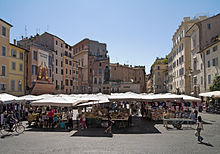

The great buildings of the 20th century were almost all erected in the outskirts like the EUR; In the inner city, on the other hand, building measures are rarely allowed for reasons of monument preservation. Large excavations are currently taking place in the area of the ancient imperial forums. The past can still be found in many places in the modern cityscape. The theater of Pompey on Campo de 'Fiori, for example, dates from the 1st century BC. BC, in whose forecourt in Caesar's time the curia was housed and where he was probably killed, still largely preserved. However, over the centuries the semicircle has become a residential development for the audience. Today there are cellars and an underground car park, restaurants and bars, private apartments and hotel guest houses. Due to the original semicircular theater structure, all rooms have a trapezoidal floor plan.
Renewing the city often poses major problems for the Romans in everyday life. Even the construction of a huge underground car park in a tuff hill on St. Peter's Square in 2000 was controversial because the destruction of archaeological remains was feared. For the same reason, the urgently needed third metro line was only opened in 2014/2015.
The often ugly suburbs with their high crime rate cause bigger problems than the historic city center. There are still no green areas or sports facilities there, and there are insufficient connections to local public transport. To this day, there are hardly any public baths in the former city of “thermal baths for everyone”. The Romans, who can afford it, own an apartment in one of the often greened and carefully tended inner courtyards or even a small villa in the city area.
In a ranking of cities according to their quality of life, Rome ranked 57th out of 231 cities worldwide in 2018.
Population development
Rome's history began around 800 BC. With an alliance of various small villages with a few hundred to a thousand inhabitants. From then on, Rome grew continuously over the next few centuries into a megacity with a population of over a million. In the course of the relocation of important capital functions to Constantinople in the 4th century and the collapse of the Western Roman Empire in the 5th century, the population decreased significantly and quickly fell to around 100,000 by the year 530.
In the early Middle Ages , Rome was a small town with 20,000 inhabitants compared to today. Only with the rise of the Papal States did Rome flourish again, with wars and epidemics repeatedly interrupting this development. When it became the capital of united Italy in 1871, it had a good 210,000 inhabitants, thirty years later it was already twice as many. In the 20th century Rome grew again to become a metropolis, with the number of inhabitants increasing dramatically, especially after 1945. The following overview shows the number of inhabitants according to the respective territorial status. Up to 1858 these are estimates, from 1871 to 2015 they are census results and updates from the National Institute for Statistics ( ISTAT ).
|
|
|
(*) Western Schism 1309-1376, plague 1348 /50
(**) Sack of Rome in 1527 (looting by German mercenaries as well as Spanish and Italian mercenaries)
Religions
In ancient times, the Roman religion with its cults was the most widespread religion in the city. However, other religions were also represented in this cultural center, such as the Mithraic cult and other mystery cults . On the Palatine Hill there was a temple of Cybele or Magna Mater , in the quarter to the right of the Tiber, the Trastevere , where the Jewish community had originally also settled, was a Syrian shrine, on the Capitol there was a shrine of Serapis and a temple for Isis and Serapis, the Iseum Campense, existed on the Field of Mars .
A Christian community emerged in the city very early on, and it grew rapidly despite the persecution of Christians.
With the reign of Constantine the Great , Christianity took off in the Roman Empire and also survived its decline. The bishops of Rome claimed leadership over the Church as the successor to the Apostle Peter and accepted the title of Pope . After the city was plundered and destroyed several times by pagan peoples, Rome established itself as the religious center of the Western Church and since the 8th century as the center of the Papal States. As a result, numerous churches were built in Rome that house the main ecclesiastical shrines.
In 1797 Rome was conquered by Napoleon Bonaparte in the Italian campaign . After the Congress of Vienna in 1815 it was again placed under papal sovereignty . The Italian national consciousness had grown under the French occupation (see Risorgimento ). In 1861 the Kingdom of Italy was founded. When France withdrew its protection troops from Rome as a result of the Franco-Prussian War , Italian troops conquered the Papal States on September 11, 1870; there was no resistance to speak of. On September 20, 1870 Rome was captured ( Breccia di Porta Pia ), the secular rule of the Popes over Rome was irrevocably ended. The Pope then withdrew to the Vatican , which was recognized as an independent state in the Lateran Treaty in 1929 .
Rome and especially the Vatican are the spiritual center of the Roman Catholic Church to this day . The Roman Catholic Church clearly shapes the cityscape with its large number of churches, monasteries and other religious institutions, priests, friars and sisters. In total there are over 900 Catholic churches in Rome , which bear witness to all architectural epochs in European history from antiquity to the present day. In the diocese of Rome , which includes the urban area with the exception of Ostia, 2,355,984 inhabitants (82% of the population) were Catholic. The proportion of Catholics fell from 97% in 2002 to 82% in 2011, which is due to both secularization and immigration of people of different faiths. Since 2011, however, the proportion of Catholics in the population has remained constant at around 82%.
The oldest religious minority are the Jews in Rome , who have been recorded in the city since the 2nd century BC. Since the 16th century, the Roman Jews had to live in the ghetto , which was only abolished in 1870 with the end of the Papal States. As a sign of the self-confidence of the Jewish community, the Great Synagogue ( Tempio Maggiore ) was built between 1901 and 1904 and survived the persecutions and deportations during the Second World War unscathed. Today around 20,000 Jews (0.7% of the population) live in Rome.
The Protestants of various denominations are only a small minority in Rome. They too have only enjoyed religious freedom since 1870; before that, for example, the Cimitero acattolico (also known as the “Protestant Cemetery”) was laid out outside the city walls for German and British Protestants. After Rome became the capital of the Italian nation-state, the Waldensians coming from Piedmont built the representative Waldensian church ( Tempio Valdese di Roma ) and other churches in the city.
Through immigration , two other religious communities are now also represented in the city to a notable extent: The Orthodox Christians , like in all of Italy, form the largest religious minority, among them the Romanian Orthodox are the largest group; their number was estimated at around 114,000 (4% of the population) in 2014. Muslims come mainly from Albania , Morocco , Pakistan , Bangladesh and other countries in North Africa , the Middle East and South Asia ; their number was 101,000 at the end of 2014 (3.5% of the population). Between 1984 and 1995, the mosque of Rome was built in the north of the city , which was then the largest in Europe; there are also some smaller mosques . There are also other minorities such as Hindus , Buddhists and Jehovah's Witnesses, as well as non-denominational groups .
politics
Local council
The municipal council of Rome , the Assemblea Capitolina , with its 48 members has the following composition after the local elections in 2016:
- Majority parliamentary group: 29 seats
- MoVimento 5 position : 29 seats (2013: 4 seats)
-
Opposition : 19 seats
- Partito Democratico : 7 seats (2013: 19 seats, 2008: 18 seats)
- Fratelli d'Italia : 4 seats (2013: 2 seats)
- Lista Alfio Marchini Sindaco (affiliated with Forza Italia): 2 seats (2013: 3 seats)
- Lista Con Giorgia Meloni Sindaco (linked to Fratelli d'Italia): 2 seats
- Lista Roberto Giachetti Sindaco (affiliated with Partito Democratico): 1 seat
- Forza Italia : 1 seat (2013: Il Popolo della Libertà 8 seats, 2008: 35 seats)
- Sinistra x Roma: 1 seat (2013: Sinistra Ecologia Libertà 4 seats, 2008: 2 seats)
- Non-attached : 1 seat (elected on the Lista Marchini Sindaco)
The municipal council meets in the Aula Giulio Cesare in the Senator's Palace . The president is Marcello De Vito ( M5S ).
mayor

On June 19, 2016, Virginia Raggi ( M5S ) was elected as the new mayor of Rome in a runoff election. In the first ballot on June 5, 2016, she received the most votes with 35.26% against several opposing candidates. The candidate of the Partito Democratico Roberto Giachetti achieved second place with 24.91% of the vote. Raggi won the runoff election, which was then required, with 67.15% of the vote. In the local council election, which took place at the same time, Raggi's party MoVimento 5 Stelle achieved an absolute majority in the local council and in 12 of the 15 city districts.
Ignazio Marino ( PD ) was elected mayor in the runoff elections on June 9 and 10, 2013 . He won with 63.9% against the incumbent Gianni Alemanno ( PdL ). However, Marino had to resign in October 2015. On November 1, 2015, Francesco Paolo Tronca took over the official business on a provisional basis until a new mayor was elected.
Giovanni Alemanno was elected Mayor of Rome on April 28, 2008. In the runoff election he achieved 53.7% of the vote against the former mayor Francesco Rutelli . The previous mayor, Walter Veltroni , was elected in 2001 and was confirmed in office on May 28, 2006 for a second term with 61% of the votes in the first ballot. Giovanni Alemanno failed with only 37.1%. Veltroni resigned as mayor on February 13, 2008 because of his candidacy in the parliamentary elections.
|
|
Coat of arms and symbols of sovereignty
The coat of arms of the city of Rome shows a red shield with the acronym S.PQR and a crown set with precious stones.
SPQR stands for the Latin Senatus Populusque Romanus ' Senate and People of Rome' or 'the (Roman) Senate and the Roman People'.
This lettering was the emblem of ancient Rome and can still be found today as a motto in the city's coat of arms, as well as on numerous tablets, statues, manhole covers and public facilities. The legions of the Roman Empire carried it on their standards.
Town twinning
In the form of a city partnership , Rome has only been linked to one city worldwide, and that has been with Paris since 1956 .
In addition, Rome has so-called friendship and cooperation agreements with the following cities:
Capital and seat of government
As the capital of Italy, Rome has been the seat of many state institutions and bodies since 1871. The Chamber of Deputies, the larger chamber of the Italian Parliament, has its seat in Palazzo Montecitorio near the Pantheon, while the Senate meets in Palazzo Madama .
The President of Italy has his official residence in the Quirinal Palace , which used to be the administrative building of the Papal States and from 1871 to 1946 the residence of the Italian kings . The Prime Minister's official residence has been in the Palazzo Chigi since 1961 , while it was previously in the Palazzo del Viminale, built in 1925. In addition, all government ministries are based in Rome.
The city is the seat of 138 foreign embassies in Italy, including the German and Austrian embassies.
All four current Italian intelligence services have their headquarters in Rome .
Culture and sights
overview
According to tradition, Rome was founded in 753 BC. Founded on one of the seven hills. However, finds suggest that as early as 1000 BC BC human settlements must have existed in this area. The image of the Palatine Hill and the valley to the north is determined by ancient buildings.
This is due to the fact that the Palatine Hill was the imperial residence hill during the imperial era, while the Roman Forum , the center of urban life in ancient Rome , was located in the valley between the Palatine Hill and the Capitol .
The area within the Aurelian Wall , which was built in the 3rd century around the area of the seven hills Capitol , Quirinal , Viminal , Esquiline , Caelius , Aventine and Palatine , is the inner city of Rome . The historical center extends largely on the left bank of the Tiber. Most of the largest monuments from antiquity are located here . The Christian buildings, on the other hand, are scattered on both sides of the Tiber. The Vatican City with St. Peter's Basilica, which can be seen from afar, is located on the right side of the Tiber. The historic center of Rome, St. Peter's Basilica and the Vatican City were declared World Heritage Sites by UNESCO in 1980 .
The outer city and periphery of Rome are in the area outside the Aurelian wall. The concentration of ancient buildings is significantly lower here, even if you come across them again and again. However, there are numerous churches that were also built in this area, such as the Basilica of Saint Paul Outside the Walls .
The mosque of Rome , built in 1995 , 1150 years after a failed siege by Muslims, was the largest mosque in Europe and a center of Islam in Italy until 2005 .
Buildings
As one of the great cultural cities of Europe, Rome is home to numerous monuments from the time of the Etruscans to the present, although evidence from the time of the Etruscan kings and early Roman history is rather sparse. The legacies from the era of the Roman Empire are all the more extensive .

They range from the almost completely preserved Pantheon (founded in 27 BC, rebuilt between 118 and 128 AD), the only surviving dome structure from antiquity , to the impressive Colosseum (completed in 80 AD), the largest Ancient amphitheater that hosted gladiatorial fights and other spectacles. Since 1999 the Colosseum has also served as a monument against the death penalty : Whenever a state in the world abolishes the death penalty, the Colosseum is brightly lit for 48 hours - but this rarely happens.
In addition to the ancient city walls, the city has triumphal arches, unique churches and palaces as well as large public squares; Particularly important are the Roman Forum and the Imperial Forums , as well as the Caracalla Baths (built around 217 AD), which are now used as the setting for opera performances in summer, the catacombs - widely ramified underground facilities in which Christians conduct their services celebrated and buried - and the Castel Sant'Angelo , which was built as a mausoleum for the Roman emperor Hadrian and expanded into a fortress in the Middle Ages .
The church of San Paolo fuori le mura was built in the 4th century and rebuilt after being destroyed by fire in 1823. The Basilica of San Giovanni in Laterano was built in the 4th century and essentially rebuilt in the 17th and 18th centuries. The 5th century church of San Pietro in Vincoli was restored in the 15th century and houses the famous statue of Moses by Michelangelo Buonarroti .
Other important buildings are the Piazza Navona with three fountains (including the Fontana dei Quattro Fiumi, a major work by the Italian sculptor Gian Lorenzo Bernini ), the Piazza del Campidoglio ( Capitol Square with a bronze statue of the Emperor Marcus Aurelius, which was built in the 2nd century AD) . was completed), the Fontana di Trevi (a Baroque fountain from the 18th century, into which tourists traditionally throw coins and make a wish) and the Piazza di Spagna with the famous 18th century Spanish Steps , the up to the 15th century church of Santa Trinità dei Monti .

Other attractions of Christian Rome are scattered across the city. The Christian center is the inaccessible state of the Vatican City with St. Peter's Basilica . Other large churches such as the Lateran Basilica , Santa Maria Maggiore , and Saint Paul Outside the Walls are located within the urban area. Most of the churches are particularly lavishly decorated and contain priceless works of art.
The Great Synagogue is also worth seeing and can be seen from all panoramic points .
Sights of modern Rome are more likely to be found in the outer districts of the city, such as buildings for the 1960 Summer Olympics , designed by Pier Luigi Nervi , one of the leading Italian architects of the 20th century, but also memorials and skyscrapers. All over the city there are numerous other monuments, squares, fountains and obelisks, which were created and lavishly decorated by great artists. In the west of the city, the Corviale residential complex, the longest residential building in Europe , was built between 1972 and 1982 .
Parks and squares


Among the numerous princely villas that surrounded papal Rome, there are still Villa Borghese , Villa Ada and Villa Doria Pamphili with their huge parks . In Rome, villa usually refers to the park, not the building. Other parks are:
- Colle Oppio (Esquilin), near the Colosseum , there is the Domus Aurea .
- Parco degli Acquedotti , green space with the remains of seven aqueducts
- Parco Nemorense , also called Parco Virgiliano , near Via Nemorense.
- Parco Savello (also: Giardino degli Aranci), green area on the Tiber - with orange trees
- Parco degli Scipioni near the Porta Latina .
- Municipal Rosarium (Roseto comunale), at the Circus Maximus , on the slopes of the Aventine .
- Villa Albani , in the Nomentano-Trieste district.
- Villa Aldobrandini , on Via Nazionale .
- Villa Balestra , in the Parioli district .
- Villa Bonelli , between Via della Magliana and Via Portuense.
- Villa Borghese
- Villa Carpegna , above Via Gregorio VII, Aurelio district.
- Villa Celimontana , on the Caelius , near the Colosseum.
- Villa Chigi , in the Trieste district.
- Villa Corsini , houses the zoological garden of Rome, the Bioparco Rome .
- Villa Farnesina in Trastevere (Via della Lungara) houses the Accademia dei Lincei .
- Villa Fiorelli , near Via Montepulciano
- Villa Giulia , near Piazzale delle Belle Arti, houses the Museum of Etruscan Art (Museo d'Arte Etrusca).
- Villa Glori , also known as Parco della Rimembranza , in the immediate vicinity of della Villa Ada .
- Villa Gordiani , near Via Prenestina.
- Villa Lazzaroni , near Via Appia Nuova.
- Villa Leopardi , near Via Nomentana.
- Villa Medici , by the Trinity Church (Trinità dei Monti), seat of the Accademia di Francia.
- Villa Mercede , near Via Tiburtina, near the San Lorenzo district .
- Villa Paganini , recently restored, near Via Nomentana.
- Villa Sciarra , on Via Calandrelli.
- Villa Stuart , in the Monte Mario district.
- Villa Torlonia (built by Giuseppe Valadier ), near Via Nomentana.
Museums
The oldest museums in Rome are the Capitoline Museums , established in 1471 , which, along with the much larger Vatican Museums, are among the most important art collections in Rome.
In the Villa Giulia , the country house of Pope Julius III. , which was built in the middle of the 16th century, houses an outstanding collection of Etruscan and ancient Roman art . The Borghese family's art collection is exhibited in their early 17th century palace. It bears the name Galleria Borghese and consists mainly of paintings and sculptures.
The worldwide outstanding archaeological collection of the Museo Nazionale Romano is spread over five locations and is housed in the Palazzo Massimo alle Terme, the Aula Ottagona, the Palazzo Altemps , the Diocletian's Baths and the Crypta Balbi . Also important are the picture galleries in the Palazzo Doria-Pamphilj , in the Palazzo Colonna and in the Palazzo Corsini , the Renaissance bronze collection in the Palazzo Venezia and the painting collection in the Palazzo Barberini .
The modern age is represented by the MAXXI . The futuristically designed building by architect Zaha Hadid was opened in 2009 and sees itself as a creative space and laboratory for contemporary art and architecture.
theatre
Rome plays a leading role in Italian cultural life. In the city's opera house, the Teatro dell'Opera di Roma , which is one of the largest in Italy, opera performances and ballets are offered in the stagione ; in summer the performances take place in the Caracalla baths. There are also around 150 theaters and six concert halls in Rome, which offer a varied program outside of the summer months.
One of the oldest theaters in Rome is the Teatro Argentina , which dates back to 1732. The Teatro Eliseo was opened in 1900 and offers space for 760 guests in the large auditorium and 265 in the smaller hall. In April 2002, the Auditorium Parco della Musica concert park was opened in the northern part of the city ; The approximately 50,000 square meter area includes, among other things, three concert halls with 700, 1,200 and 2,700 seats, which were built according to plans by the Genoese architect Renzo Piano .
music
Art music
Given the significant role Rome played over the centuries, it is hardly surprising that it was also one of the most important centers of music during the Renaissance and Baroque periods. Not only in the papal chapel of the Vatican, but also in the numerous churches in Rome itself, many important musicians worked. The leading positions in the 15th and first half of the 16th century were mostly in the hands of the " Dutch " (i.e. in the contemporary sense of masters of Franco-Flemish polyphony), French, and especially in the Sistine Chapel also by Spaniards. The most important musicians of the Renaissance in Rome were: Josquin Desprez (approx. 1455–1521), who sang in the papal chapel from around 1486 to 1495, and Cristóbal de Morales (1500–1553), who was a member of the papal chapel from 1535 to 1545 Chapel and published several missals in Rome; for a short time (1553–1554) the young Orlando di Lasso (1532–1594) also worked here as Kapellmeister of San Giovanni in Laterano ; Tomás Luis de Victoria (approx. 1548–1611) lived in Rome for twenty years from 1565 to 1585, and from 1571 was Kapellmeister of the Seminario Romano .
The first important native composer in Rome was Costanzo Festa (1490–1545), but the most influential and famous of all was the great vocal polyphonist Giovanni Pierluigi da Palestrina (1525–1594), who skillfully implemented the strict demands of the Counter-Reformation for greater text intelligibility, and therefore, for centuries it was considered to be the innovator and “savior” of church music. He was not only Kapellmeister of the Pope in the Vatican, but also temporarily in the Lateran , in Santa Maria Maggiore , and at the Seminario Romano. He was followed by a whole school of Roman church composers , including Gregorio Allegri (1582–1652), whose Miserere, sung in the Capella Sistina during Holy Week, had an almost mystical reputation well into the 19th century and was recorded by Mozart in 1770 by ear . In the 17th century the decades on established German College acting Giacomo Carissimi (1605-1674), the oratorio as a religious alternative to the opera . The German Jesuit and writer Athanasius Kircher also lived and worked in Rome , whose Musurgia Universalis , his most famous work, published in 1650, also provides insights into contemporary Roman musical life.
In the field of instrumental music stand out: the organists and harpsichordists Girolamo Frescobaldi (1583–1643) and Bernardo Pasquini (1637–1710), and the violinist Archangelo Corelli (1653–1713), whose sonatas and concerti grossi had a significant influence on music his time had, among others also on Johann Sebastian Bach (1685–1750) and Georg Friedrich Händel (1685–1759). During his trip to Italy at the beginning of the 18th century, he was also temporarily in Rome, where he created a number of important youthful works that premiered here, including the spectacular Dixit Dominus (HWV 232) and the oratorio Il trionfo del Tempo e del Disinganno .
In the 17th and 18th centuries, Roman opera was marked by a papal ban on women from appearing, which was ultimately one of the main reasons for the success of the castrati , who also sang in the papal chapel and the hundreds of Roman churches. At times in the 17th and early 18th centuries, some popes also tried to suppress opera altogether, which gave the oratorio a special boost as a substitute. Such anti-music tendencies, however, faced many important music lovers and patrons, such as the Cardinals Pietro Ottoboni and Benedetto Pamphilj , who not only put on performances in their own palaces, but even wrote texts for cantatas , oratorios and operas themselves ; Among the famous music patrons of Rome are the ex-queens Christine of Sweden and Maria Casimira of Poland, as well as various nobles, such as Prince Francesco Maria Ruspoli . The most important musicians who worked as opera and oratorio composers in Rome include: Luigi Rossi (around 1598–1653), Alessandro Stradella (1639–1682), Bernardo Pasquini (1637–1710), Alessandro Scarlatti (1660–1725), Antonio Caldara (1670–1736) and Domenico Scarlatti (1685–1757).
Although Rome was less important in the history of opera, especially in the 18th and 19th centuries, compared with Venice , Naples and Milan , some of the most famous operas were premiered in Roman theaters, including Rossini's Il barbiere di Siviglia (in the Teatro Argentina 1816 ), Verdi's Il trovatore ( Teatro Apollo , 1853) and Un ballo in maschera (Teatro Apollo, 1859) and Puccini's Tosca ( Teatro Costanzi , 1900) - the action of the latter also takes place in Rome, among others. in the Castel Sant'Angelo.
In the 20th century Ottorino Respighi (1879–1936) worked in Rome, who set a musical monument to the eternal city with his symphonic poems Fontane di Roma (1916), Pini di Roma (1924) and Feste Romane (1928).
For classical music, the Auditorium Parco della Musica was built in 2002 near the park of Villa Glori, in the northern part of the city. It can be reached via tram line 2 at the Apollodoro station.
Folk music
The first traces of Roman folk music date from the 13th century, with the song Sonetto (also known as Bella quanno te fece mamma tua ), which later became popularly eponymous for the Roman musical tradition. According to the composer Alessandro Parisotti, the melodic characteristics of these songs have remained practically unchanged over the centuries.
The year 1890 is widely considered to be the year of the birth of modern Roman song, with the publication of the song Feste di maggio (with a text by Giggi Zanazzo , the "father" of modern Roman song, and music by Antonio Cosattini) for a beauty contest in Rome on the occasion of the 20th anniversary of the capital city status. The success of the title aroused the interest of the Roman artist scene, whereupon in 1891 the publishers Pietro Cristiano and Edoardo Perino initiated the first music competitions for Roman songs. The competition tradition quickly gained a foothold here and was linked to the celebrations for St. John's Day ; it lasted until the outbreak of World War II .
Culinary specialties
The culinary offer in Rome is varied and ranges from the cuisine of famous chefs such as Heinz Beck to typical Roman cuisine with influences from Jewish cuisine for the preparation of shellfish, specialties from Lazio and fish dishes.
Typical dishes of Roman cuisine are the coda alla vaccinara , oxtail cooked in wine with tomatoes and peppers, the pajata , stuffed veal intestine with tomato sauce, the abbacchio alla scottadito (milk lamb cutlets ), or the trippa alla romana ( tripe in tomato and mint sauce), the have been refined over time and are now specialties. The supplì , fried rice dumplings filled with mozzarella , stuffed zucchini flowers and bruschette , toasted bread slices with oil and garlic or in many other variations, for example with tomatoes, are also tasty . Another Roman specialty are different ways of preparing young artichokes , for example alla Romana steamed in the oven with garlic and mint or deep-fried alla Giudea , and the popular baccalà , deep-fried cod fillets , which are often eaten as a snack in between meals, comes from the Jewish-Roman cuisine . Another popular snack in the city and the surrounding area is porchetta , a roast roast made from boned suckling pig .
Two of the most famous pasta dishes also come from Rome, the bucatini all'amatriciana and the spaghetti alla carbonara . They belong to four typical, related pasta preparations of the Roman cuisine: cacio e pepe (only with pecorino and pepper), alla gricia (pecorino, pepper, guanciale ) all'amatriciana (pecorino, pepper and / or peperoncini , guanciale, tomatoes) and alla carbonara (pecorino, pepper, guanciale, egg). According to legend, the latter was invented during the occupation for American soldiers as a substitute for their typical breakfast with bacon and egg. The fact is that evidence of the name and recipe has only been found since the post-war period.
In contrast to the Neapolitan pizza, the Roman pizza is often a pizza bianca without tomato puree; Both pizza bianca and pizza rossa are available in different ways.
Sports

There are two nationally and internationally important football clubs in the city: Lazio Rome, which was founded in 1900, and AS Rome, which was founded in 1927 . Both clubs play their home games in the Olympic Stadium, which holds around 73,000 spectators . The stadium is in the north of the city.
AS Roma became three times Italian champions and nine times Italian cup winners . Lazio was two champions, six times cup winners and won the European Cup Winners' Cup once .
Rome hosted the 1960 Summer Olympics and the first ever Paralympics .
The Italian national rugby union team plays their home games in the Olympic Stadium during the annual Six Nations .
The Rome Marathon is held on a Sunday in March every year . The Roma - Ostia half marathon will take place a few weeks earlier .
Economy and Infrastructure
economy
According to a study from 2014, the greater Rome area generated a gross domestic product of 163.2 billion US dollars (KKB). In the ranking of the economically strongest metropolitan regions worldwide, it was 76th. The GDP per capita was $ 38,025 compared to 41,147 for the greater Milan area. A total of around 2 million people are employed here.
Rome has been the most dynamic business location in Italy since the Second World War . Its economy is based on service industries, benefits in particular from resident state-owned companies and large corporations ( Eni , Enel , Leonardo , Poste Italiane , RAI , Telecom Italia , Unicredit ) as well as tourism. In addition, the wholesale and retail trade dominate.
As an industrial location, Rome mainly produces traditional industrial products, textiles and souvenirs for tourists, as well as newer products such as food , pharmaceutical products , machines , paper and metal goods. In addition, Rome is an important location for the film industry ( Cinecittà ) because of its climate and monuments .
tourism
Tourism plays an important role in the economy of Rome. With almost 7.1 million foreign visitors, Rome was the 16th most-visited city in the world in 2016 and ranked sixth in Europe. Foreign tourists generated revenues of $ 4.5 billion in the same year. Most of the foreign visitors came from Europe, Asia and the USA.
traffic
Air traffic
Rome has three airports. The Roma-Fiumicino “Leonardo da Vinci” intercontinental airport located on the coast is the most important hub for Italian air traffic and Italy's main airport, as well as the main hub of the largest Italian airline Alitalia . It is commonly known as Fiumicino Airport because it is located in the municipality of Fiumicino, southwest of Rome. The older Rome Ciampino Airport is a mixed commercial and military airport. It is often referred to as Ciampino Airport because it is located in Ciampino, southeast of the city. The small Rome-Urbe airport is primarily intended for general aviation and is located approximately 6 km north of the city center.
railroad
As one of the central hubs of the Italian railway system, Rome has the train stations Roma Tiburtina , Roma Ostiense, Roma Tuscolana, Roma Trastevere , Roma San Pietro, Roma Aurelia and Roma Termini train station . Termini is one of the largest train stations in Europe and one of the most frequently used in Italy, with around 400,000 travelers daily. With the commissioning of the new high-speed rail line to Naples and the expansion of the Roma Tiburtina station , trains that only pass through Rome as a through station will no longer stop at Termini central station. The Roma Smistamento marshalling yard (Italian: 'marshalling yard') in the north of the city will continue to be used as a freight yard after its closure .
Also in Rome is the short line of the Vatican State Railways branching off from Roma San Pietro train station and serving only rail freight traffic , which was built in 1856 under Pope Pius IX. opened.
Road traffic
Rome is located in the center of a star-shaped network of streets, which, starting from the Capitoline Hill, follows the course of the ancient streets and at that time connected Rome with its empire. Today, Rome is surrounded by a motorway ring (the Grande Raccordo Anulare or GRA ), which is about ten kilometers from the city center.
The city is struggling with severe traffic problems, as the star-shaped road system only allows residents to choose between driving through the historic center or on the crowded ring road. The metro system, which is quite small compared to other cities of the same size, does not provide any remedy either. In addition, there are only 21 taxis for every 10,000 inhabitants in Rome, far fewer than in other major European cities.
In some areas of the city center designated as a restricted traffic zone (ZTL) ( Zona a Traffico Limitato ), only limited vehicle traffic is possible during the daytime. This means that private cars are only allowed to use them during the day between 6 a.m. and 6 p.m. with a special permit. The zones were established because of the chronic congestion of road traffic during the 1970s and 1980s. In the two districts of Trastevere and San Lorenzo , on the other hand, night traffic is so heavy that corresponding ZTLs have been set up there during the night. A night-time ZTL is also planned in Testaccio . However, a generous practice of exemptions has diluted the effect. Foreign coaches are asked to pay in Rome with import fees of up to 210 euros (as of 2009) and are then only allowed to park for a limited period or not at all.
Local public transport
Local public transport in Rome is largely operated by the urban transport company ATAC . The transport system of the ATAC includes buses, trolley buses , road , suburb - and subways . In addition, there are the S-Bahn -like FL lines operated by Trenitalia and the regional bus network operated by COTRAL and other providers. These modes of transport are integrated into the Metrebus tariff network.
The bus network includes 350 bus routes with more than 8000 stations. The Rome tram started operating on August 2, 1877. It runs in six lines on a 51.31 kilometer network and has 192 stops. After trolleybuses had already operated in Rome between January 8, 1937 and July 2, 1972 , the system was reintroduced on a line of 11.3 km after an interruption of 33 years on March 23, 2005.
The metro system ( Metropolitana di Roma ) has three lines A, B and C with a total of 74 stations over a length of 60 km (as of May 2016). The two underground lines A and B cross in Termini. The expansion of the underground network was slow, as it was feared that many historical buildings and systems would be damaged by the construction of further tunnels. Bureaucratic and financial problems were other obstacles.
The first line was opened in 1954 and connected Termini with the Eur district , where the planned world exhibition was to take place in 1942 . Line B operates on this route today . The line A was opened in 1980, linking the stations Ottaviano and Anagnina. The expansion to Battistini lasted from 1999 to 2000. In the 1990s, line B was expanded from Termini to Rebibbia. In 2012, line B was expanded to include a 3.9 km branch with five stations (B1), which runs from the Piazza Bologna train station to the new Jonio terminus. The first section of Line C was opened at the end of 2014 on parts of the converted Termini-Pantano regional railway line in the south-east of Rome. In the coming years, the line was to be continued to the north under the old town of Rome. This expansion had to be postponed several times and finally stopped due to financial problems, archaeological finds and other imponderables in the planned work in the city center. It was expected to cost € 3 billion , be 25.5 km long and serve 30 stations. Line C is driven fully automatically with driverless trains. In addition, a fourth route, Line D, with 22 stations is planned. The suburban railways to Lido di Ostia , Viterbo and Giardinetti should, under certain circumstances, be fully or partially integrated into the subway network (lines E, F and G).
science and education
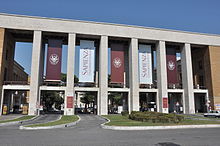
Rome has three state universities: The Università degli Studi di Roma La Sapienza is one of the oldest (founded in 1303) and with 147,000 students one of the largest universities in Europe. The other two universities are the Tor Vergata and Roma Tre . There are also several Catholic universities as institutions of the Holy See or individual religious orders. The private American University is located in the Trastevere district .
Rome is also the seat of the National Academy of Sciences ( Accademia Nazionale dei Lincei ), the Pontifical Academies , the Accademia di San Luca , the National Academy of Dance, the National Academy of Dramatic Arts, the Conservatory of Music and the Central Institute for the Restoration of Works of Art .
media
Several daily and weekly newspapers are published in Rome: La Repubblica , Il Messaggero , Il Tempo , Il Foglio , Il manifesto , liberazione .
The film city of Cinecittà is also very well known for successful productions.
The radio company Radiotelevisione Italiana also has its headquarters in Rome.
International organizations
Numerous international companies and organizations have their headquarters in Rome. These include the Food and Agriculture Organization of the United Nations (FAO), the International Fund for Agricultural Development (IFAD), the World Food Council (WFC) and the World Food Program (WFP).
Personalities
sons and daughters of the town
Personalities who worked in Rome
Film productions
The following list shows a selection of films and series shot completely or partially in Rome:
- Rome, Open City (Roma, città aperta) , directed by Roberto Rossellini , 1945
- Paisà , directed by Roberto Rossellini, 1946
- Bicycle thieves (Ladri di biciclette) by Vittorio de Sica based on a novel by Luigi Bartolini , 1948
- Quo vadis? , Directed by Mervyn LeRoy , 1951 (in the Cinecittà studios)
- A Heart and a Crown (Roman Holiday) , directed by William Wyler , 1953
- Three Coins in the Fountain (Three Coins in the Fountain) , directed by Jean Negulesco , 1954
- The nights of Cabiria (Le notti di Cabiria) , directed by Federico Fellini , 1957
- The sweet life (La dolce vita) , directed by Federico Fellini, 1960
- Accattone - Who never ate his bread with tears (Accattone) , directed by Pier Paolo Pasolini , 1961
- Mamma Roma , directed by Pier Paolo Pasolini, 1962
- Love 1962 ( L'eclisse ), directed by Michelangelo Antonioni , 1962
- This is how we travel and how we love ( If It's Tuesday, This Must Be Belgium ), directed by Mel Stuart , 1969
- Fellinis Roma (Roma) , directed by Federico Fellini, 1972
- Dear Diary ... (Caro diario) , directed by Nanni Moretti , 1993
- The Talented Mr. Ripley , directed by Anthony Minghella , 1999
- People in Rome (Gente di Roma) , directed by Ettore Scola , 2003
- The best years ( La meglio gioventù ), directed by Marco Tullio Giordana , 2003
- Ocean's 12 ( Ocean's Twelve ), directed by Steven Soderbergh , 2004
- Rome (TV series) ( Rome ), 2005-2007
- Mission: Impossible III , directed by JJ Abrams , 2006
- Il Divo , directed by Paolo Sorrentino , 2008
- Illuminati ( Angels and Demons ), directed by Ron Howard , 2009
- Habemus Papam - A Pope Büxt aus , Director: Nanni Moretti, 2011
- Caesar must die ( Cesare deve morire ), directed by Paolo and Vittorio Taviani , 2012
- To Rome with Love , directed by Woody Allen , 2012
- The Other Rome (Sacro GRA) , directed by Gianfranco Rosi , 2013
- La Grande Bellezza - The Great Beauty , directed by Paolo Sorrentino, 2013
- James Bond 007: Specter , directed by Sam Mendes , 2015
- The Young Pope , directed by Paolo Sorrentino, 2016
- Suburra: Blood on Rome , directed by Giuseppe Capotondi , Michele Placido , 2017
- John Wick: Chapter 2 ( John Wick: Chapter 2 ), directed by Chad Stahelski , 2017
- Loro - Die Verführten , directed by Paolo Sorrentino, 2018
- Dogman , directed by Matteo Garrone , 2018
- The two popes ( The Two Popes ), directed by Fernando Meirelles , 2019
- The New Pope , directed by Paolo Sorrentino, 2020
- Mission: Impossible 7 , directed by Christopher McQuarrie , 2021
literature
- Literature on history
Generally
- Steffen Bogen and Felix Thürlemann : Rome - A City in Maps from Antiquity to Today , Primus Verlag, Darmstadt 2009, ISBN 978-3-89678-661-6 .
- Filippo Coarelli : Rome. An archaeological guide , Verlag von Zabern, Mainz 2000, ISBN 3-8053-2685-8 .
- Brigitte Hintzen-Bohlen: Art and Architecture: Rome. With contributions by Jürgen Sorges. Könemann, Tandem Verlag, 2005, ISBN 3-8331-1304-9 .
- Michael Matheus , Rome. Ancient substrate and urban development , In: The urbanization of Europe from antiquity to modernity (Kieler workpieces, series E: Contributions to social and economic history 7), ed. by Gerhard Fouquet and Gabriel Zeilinger, Frankfurt am Main 2009, pp. 191–206.
- Michael Matheus , Rome , In: European Places of Remembrance , Volume 2 ( Das Haus Europa ), ed. by Pim den Boer, Heinz Duchhardt , Georg Kreis , Wolfgang Schmale , Munich 2012, ISBN 978-3-486-70419-8 , pp. 263-279.
- Martin Mosebach : Rome, Eternal City, Longing in the Cliché? CORSOfolio 1 . CORSO, Hamburg 2010. ISBN 978-3-86260-005-2 .
- Volker Reinhardt , Michael Sommer : Rome. History of the Eternal City , Theiss, Stuttgart 2008, ISBN 978-3-8062-2081-0 .
- Volker Reinhardt: History of Rome. From antiquity to the present (= C. H. Beck Wissen) , C. H. Beck, Munich 2008, ISBN 978-3-406-57714-7 ; Review by Volker Huneke (TU Berlin)
Antiquity
- Alexandre Grandezza: Urbs. Rome's way to the world metropolis. From the French by Nathalie Lemmens et al. wbg Zabern, Darmstadt 2019.
- Frank Kolb : Rome. History of the city in ancient times. Beck, Munich 2002, ISBN 3-406-46988-4 .
- Karl-Wilhelm Weeber : All of Rome in 7 days - A time travel guide to antiquity , Primusverlag, Darmstadt 2008, ISBN 978-3-89678-365-3 .
Christian Rome
- Clemens Bombeck: They also shaped Rome. At the graves of the saints and blessed in the Eternal City . Schnell & Steiner publishing house, Regensburg 2004, ISBN 3-7954-1691-4 .
- Ferdinand Gregorovius : History of the city of Rome in the Middle Ages from V. to XVI. Century . Dtv, Munich 1988, ISBN 3-423-05960-5 (7 vols.).
- Mirabilia Urbis Romae - The miracles of the city of Rome , translated and commented by Gerlinde Huber-Rebenich et al. Herder, Freiburg 2014, ISBN 978-3-451-30931-1 .
- Chris Wickham : Medieval Rome. Stability and Crisis of a City, 900-1150 , Oxford University Press, 2015.
- Hans Georg Wehrens: Rome. The Christian sacred buildings from the 4th to the 9th century. A vademecum. , Herder Freiburg 2017, ISBN 978-3-451-38300-7
History of trips to Rome
- Johann Wolfgang Goethe : Italian journey . 1816/1817 (online: Volume 1 , Volume 2 )
- Roberto Zapperi : All roads lead to Rome. The eternal city and its visitors . C. H. Beck, Munich 2013. ISBN 978-3-406-64451-1 .
- Literature on art
- Volker Ebersbach : Rome and its homeless poets. (Essays). Mitteldeutscher Verlag, Halle; Leipzig 1985 and 1987, ISBN 3-354-00260-3 . (Drawings by Harry Juergens).
- Jörg Ernesti : Traces of Germany in Rome - Walks through the Eternal City. Herder, Freiburg i. Br. 2020, ISBN 978-3-451-38799-9 .
- Claus-Günter Frank: Rome. Literary walks through the capital of the world. Klöpfer & Meyer, Tübingen 2000, ISBN 3-931402-55-X .
- Luigi Monzo: croci e fasci - Italian church construction in the time of fascism, 1919–1945. 2 vol. Karlsruhe 2017 (dissertation, Karlsruhe Institute of Technology, 2017), pp. 437–629 and 912–928. (Church construction in Rome from 1919 to 1945)
- Christoff Neumeister : Ancient Rome. A literary city guide. Beck, Munich 1997, ISBN 3-406-42683-2 .
- Pier Paolo Pasolini : Rome, another city. Stories and poems selected by Annette Kopetzki and Theresia Prammer. With photographs by Herbert List and an afterword by Dorothea Dieckmann . CORSO, Hamburg 2010, ISBN 978-3-86260-001-4 .
- Reinhard Raffalt : Living with Rome . Prestel, Munich 1986 ff.
- Concerto Romano . 1999, ISBN 3-7913-2236-2 .
- Fantasia Romana . 1986, ISBN 3-7913-0292-2 .
- Sinfonia Vaticana . 1996, ISBN 3-7913-0291-4 .
- Cantata Romana . 1996, ISBN 3-7913-0404-6 .
- Divertimento Romano . 1989, ISBN 3-7913-0445-3 .
- Literature on the kitchen
- Livio Jannattoni, Giuliano Malizia: La Cucina Romana e del Lazio, Roma, Newton Compton, 1998. ISBN 978-88-541-5865-8 .
Web links
|
Further content in the sister projects of Wikipedia:
|
||
|
|
Commons | - Media content (category) |
|
|
Wiktionary | - Dictionary entries |
|
|
Wikinews | - News |
|
|
Wikiquote | - Quotes |
|
|
Wikisource | - Sources and full texts |
|
|
Wikivoyage | - Travel Guide |
- Website of the city of Rome (Italian)
- Link catalog on Rome at curlie.org (formerly DMOZ )
- kirke.hu-berlin.de - online publications for further information
- Rome Reborn - Ancient Rome Resurrected - A video tour of the ancient city in A.D. 320
- Entry on the website of the UNESCO World Heritage Center ( English and French ).
- Joachim Werner: The Architecture of Rome in the Renaissance
Individual evidence
- ↑ Statistiche demografiche ISTAT. Monthly population statistics of the Istituto Nazionale di Statistica , as of December 31 of 2019.
- ↑ Tibullus, carmen 2,5,23 f: “ Romulus aeternae nondum formaverat urbis / moenia. "(German:" Romulus had not yet built the walls of the eternal city. ")
- ↑ scoperte archeologiche rivelano che Roma ha 200 anni di più - Focus.it. Retrieved June 4, 2020 .
- ↑ UNESCO World Heritage List (accessed on January 29, 2011)
- ↑ CIL 01, 00561 .
- ↑ Dionysius of Halicarnassus, Antiquitates Romanae 1,72–73.
- ^ Gerhard Köbler : Dictionary of the Old High German vocabulary. Schöningh, Munich 1993, p. 895 sv Rōma ( online ).
- ↑ Rome in Middle High German dictionary (MWB online) of the Mainz Academy of Sciences and Literature and the Academy of Sciences in Göttingen .
- ↑ As an example, reference is made to the extensive description in Plutarch , Romulus 1–9.
- ↑ Plutarch, Romulus 1.
- ^ Servius , Commentary on Virgil's Aeneid 1,273.
- ↑ Paolino Mingazzini : L'origine del nome di Roma ed alcune questioni topografiche attinenti ad essa. La Roma quadrata, il sacello di Volupia, il sepolcro di Acca Larenzia. In: Bullettino della Commissione Archeologica Comunale di Roma. Volume 78, 1961-1962, pp. 3-18; Edmond Jung: Les noms du Tibre et de Rome. Matériaux et questions. In: Revue Internationale d'Onomastique. Volume 23, 1971, pp. 189-205; Volume 24, 1972, pp. 33-61.
- ^ Servius, Commentary on Virgil's Aeneid 8: 63.90.
- ^ Massimo Pittau : Sul significato e l'origine del toponimo "Roma". In: Rosa Bianca Finazzi, Paola Tornaghi (ed.): Lingue e culture in contatto nel mondo antico e altomedievale. Atti dell 'VIII Convegno internazionale di linguisti tenuto a Milanonei giorni September 10-12, 1992. Paideia, Brescia 1993, pp. 453-466, here p. 460; see also the article Roma on the author's website; at last the same: Studi sulla Lingua Etrusca. Kindle Book 2018, p. 452 f.
- ^ Wilhelm Schulze : On the history of Latin proper names (= treatises of the royal society of sciences in Göttingen. Philological-historical class. New series 5). Weidmann, Berlin 1904, pp. 579-582, quoted on p. 581 ( digitized version ).
- ↑ See for example Carlo De Simone : Il nome del Tevere. Contributo per la storia delle più anticherelazioni tra genti latino-italiche ed etruscan. In: Studi Etruschi. Volume 43, 1975, pp. 119-157; Kurt Latte : Roman History of Religions (= Handbook of Classical Studies . Dept. 5: History of Philosophy, History of Mathematics and Natural Sciences, History of Religions , Part 4). CH Beck, Munich 1960, p. 111 note 4; Hans Volkmann : Rome. In: The Little Pauly (KlP). Volume 4, Stuttgart 1972, Sp. 1441-1444 (here: Sp. 1441). Hubert Petersmann offers a compilation of corresponding representatives : The etymological derivation of the name Roma. A linguistic contribution to research into the early history of Italy. In: Andreas Halthoff, Fritz-Heiner Mutschler (Ed.): Hortvs litterarvm antiqvarvm. Festschrift for Hans Armin Gärtner on his 70th birthday. (= Library of Classical Classical Studies . Series 2, Volume 109). Winter, Heidelberg 2000, 451-464, here p. 457, note 30.
- ^ Helmut Rix , Gerhard Meiser (ed.): Etruscan texts. Volume 1. G. Narr, Tübingen 1991, p. 121 No. Vc 7.33: Cneve Tarχunies Rumaχ “Gnaeus Tarquinius from Rome”, late 4th century BC BC, from the Tomba François .
- ↑ Compare Zsolt Simon: The etymological derivation of the name Rōma. In: Rosemarie Lühr , Sabine Ziegler (eds.): Protolanguage and Prehistory. Files from the 12th symposium of the Indo-European Society in Krakow from October 11 to 15, 2004. Reichert, Wiesbaden 2009, pp. 466–477, here p. 468 ( online ).
- ↑ Compilation by Zsolt Simon: The etymological derivation of the name Rōma. In: Rosemarie Lühr, Sabine Ziegler (eds.): Protolanguage and Prehistory. Files from the 12th symposium of the Indo-European Society in Krakow from October 11 to 15, 2004. Reichert, Wiesbaden 2009, pp. 466–477, here p. 469 note 8, which itself has a connection with Indo-European * h 2 raw 3 máh 2 'arable', 'arable land', 'arable land'> Latin rōma 'arable' suggests.
- ^ Virgil, Aeneis 1, 278-279: his ego nec metas rerum nec tempora pono: imperium sine fine dedi. German translation: Virgil : Äneide in the Gutenberg-DE project ( archive version )
- ↑ Roma Capitale. Territory. (No longer available online.) Comune.roma.it, archived from the original on October 21, 2013 ; Retrieved September 9, 2013 (Italian).
- ^ Museo della Civiltà Romana .
- ↑ Weather Rome
- ↑ wetterkontor.de
- ↑ The saga of Romulus and Remus on roma-online.de
- ^ Frank Kolb : Rome. The history of the city in ancient times. Munich 1995, p. 453f.
- ↑ Estimates range from 450,000 to three and a half million.
- ↑ Gazzetta Ufficiale del Regno d'Italia , Vol. 1871, No. 35 of February 4, 1871: Law No. 33, Art. 1: "La città di Roma è la capitale del Regno."
- ↑ Rudolf Lill : History of Italy from the 16th century to the beginnings of fascism. Scientific Book Society, Darmstadt 1980, ISBN 3-534-06746-0 , p. 195.
- ↑ Richard Overy: The Bomb War. Europe 1939–1945 . Rowohlt, Berlin 2014, ISBN 978-3-87134-782-5 , pp. 730-733.
- ^ Heinz-Joachim Fischer : Between Rome and Mecca . Bertelsmann, Munich 2009, ISBN 978-3-570-01077-8 , p. 61.
- ↑ Mercer's 2018 Quality of Living Rankings. Retrieved August 18, 2018 .
- ^ Romolo A. Staccioli: Guida di Roma antica. Milano 1994, ISBN 88-17-16585-9 .
- ^ Diocese of Roma {Rome} - Statistics. Retrieved November 9, 2019 .
- ↑ Gli Ebrei a Roma. Retrieved November 9, 2019 .
- ^ A Roma e Provincia, immigrati il 10% degli abitanti: una guida alle religioni. Retrieved November 9, 2019 .
- ↑ http://www.piuculture.it/2016/10/essere-musulmani-a-roma-dove-andare-a-pregare/
- ↑ Assemblea Capitolina. Municipality of Rome, July 22, 2016, accessed September 17, 2016 .
- ↑ Elezioni of Fine 2016. La Repubblica , June 23, 2016 accessed on 17 September 2013 .
- ↑ Elezioni of Fine 2013. La Repubblica , June 10, 2013, accessed on 10 June 2013 .
- ↑ Valeria Forgnone: Roma, Tronca si insedia in Campidoglio e poi saluta il Papa: "Da lui parole che danno la forza di andare avanti". La Repubblica , November 1, 2015, accessed September 17, 2013 .
- ^ Ministero dell'Interno ( Memento of April 30, 2008 in the Internet Archive )
- ↑ tagesschau.de (tagesschau.de archive)
- ↑ NZZ, February 13, 2008
- ↑ Paris et Rome ( Memento of January 1, 2017 in the Internet Archive ) (French), accessed on May 13, 2017.
- ^ Palazzo del Viminale on the website of the Italian Ministry of the Interior
- ↑ List of embassies in Italy on the website of the Italian Ministry of Foreign Affairs (PDF; 1.4 MB)
- ↑ Turismo Roma: Performance Venues: Theaters (147) - as of January 27, 2014
- ↑ https://en.auditorium.com/lavora_con_noi.html
- ^ Gianni Borgna: Storia della canzone italiana . Laterza, Bari and Rom 1992, pp. 29-30 .
- ^ Giuseppe Micheli: Storia della canzone romana . Newton Compton Editori, Rome 1989, p. 19 (Italian).
- ↑ Felice Liperi: Storia della canzone italiana . 2nd Edition. Rai Eri, Rome 2011, p. 36 (Italian).
- ^ Giuseppe Micheli: Storia della canzone romana . Newton Compton Editori, Rome 1989, p. 204-206 (Italian).
- ^ Gianni Borgna: Storia della canzone italiana . Laterza, Bari / Rome 1992, p. 30-31 (Italian).
- ^ Giuseppe Micheli: Storia della canzone romana . Newton Compton Editori, Rome 1989, p. 211, 578 (Italian).
- ↑ Jannattoni (1998) sv
- ^ Alan Berube, Jesus Leal Trujillo, Tao Ran, and Joseph Parilla: Global Metro Monitor . In: Brookings . January 22, 2015 ( brookings.edu [accessed July 19, 2018]).
- ↑ Global Destination Cities Report 2016. (PDF) (No longer available online.) Mastercard, archived from the original on September 24, 2016 ; accessed on July 11, 2018 . Info: The archive link was inserted automatically and has not yet been checked. Please check the original and archive link according to the instructions and then remove this notice.
- ^ Roma Tiburtina. (No longer available online.) Archived from the original on May 6, 2006 ; Retrieved December 15, 2011 (Italian).
- ↑ Peter Kiefer: Central Rome Streets Blocked by Taxi Drivers. In: New York Times. November 30, 2007, accessed December 15, 2011 .
- ↑ Route network on the ATAC website. Retrieved December 15, 2011 (Italian).
- ^ Mary Webb: Jane's Urban Transport Systems 2009-2010 . Coulsdon 2009, ISBN 978-0-7106-2903-6 , pp. 195 (English).
- ^ Franco Battel: There is no more drilling - «Capitol terminus» for the new Roman subway line. In: bernerzeitung.ch . October 6, 2019, accessed October 7, 2019 .
- ↑ Tom Kington: Roman remains threaten metro. In: Guardian (London). May 14, 2007, accessed December 15, 2011 .
- ↑ Roma-Lido, Zingaretti: "La trasformeremo in metropolitana". In: La Repubblica . January 16, 2016, accessed May 18, 2016 (Italian).
- ^ E se la ex Roma-Pantano diventasse la Metro G? (No longer available online.) In: CityRailways. December 2, 2014, archived from the original on May 18, 2016 ; Retrieved May 18, 2016 (Italian).
- ↑ Rome in the IMDb
- ↑ Bibliography on the city of Rome (Italian, accessed January 29, 2011)
← Previous location: La Storta 14.8 km | Rome | Next place: none →
![]() Canterbury |
Dover |
Calais |
Wissant |
Guînes |
Licques |
Wisques |
Thérouanne |
Auchy-au-Bois |
Bruay-la-Buissière |
Arras |
Bapaume |
Peronne |
Doingt |
Seraucourt-le-Grand |
Tergnier |
Laon |
Bouconville-Vauclair |
Corbeny |
Hermonville |
Reims |
Trépail |
Châlons-en-Champagne |
Cool |
Brienne-le-Château |
Bar-sur-Aube |
Châteauvillain |
Blessonville |
Langres |
Humes-Jorquenay |
Coublanc |
Grenant |
Dampierre-sur-Salon |
Savoyeux |
Seveux |
Gy |
Cussey-sur-l'Ognon |
Besançon |
Étalans |
Chasnans |
Nods |
Ouhans |
Pontarlier |
Yverdon-les-Bains |
Orbe |
Lausanne |
Cully |
Vevey |
Montreux |
Villeneuve |
Aigle |
Saint-Maurice |
Martigny |
Orsières |
Bourg-Saint-Pierre |
Great St. Bernhard |
Saint-Rhémy-en-Bosses |
Saint-Oyen |
Étroubles |
Gignod |
Aosta |
Saint-Christophe |
Quart |
Nut |
Verrayes |
Chambave |
Saint-Denis |
Châtillon |
Saint-Vincent |
Montjovet |
Issogne |
Verrès |
Arnad |
Hône |
Bard |
Donnas |
Pont-Saint-Martin |
Carema |
Settimo Vittone |
Borgofranco d'Ivrea |
Montalto Dora |
Ivrea |
Cascinette d'Ivrea |
Burolo |
Bollengo |
Palazzo Canavese |
Piverone |
Azeglio |
Viverone |
Roppolo |
Cavaglià |
Santhià |
San Germano Vercellese |
Olcenengo |
Salasco |
Sali Vercellese |
Vercelli |
Palestro |
Robbio |
Nicorvo |
Castelnovetto |
Albonese |
Mortara |
Cergnago |
Tromello |
Garlasco |
Gropello Cairoli |
Villanova d'Ardenghi |
Zerbolò |
Carbonara al Ticino |
Pavia |
Valle Salimbene |
Linarolo |
Belgioioso |
Torre de 'Negri |
Costa de 'Nobili |
Santa Cristina e Bissone |
Miradolo Terme |
Chignolo Po |
San Colombano al Lambro |
Orio Litta |
Senna Lodigiana |
Calendasco |
Rottofreno |
Piacenza |
Podenzano |
San Giorgio Piacentino |
Pontenure |
Carpaneto Piacentino |
Cadeo |
Fiorenzuola d'Arda |
Chiaravalle della Colomba |
Alseno |
Busseto |
Fidenza |
Costamezzana |
Noceto |
Medesano |
Fornovo di Taro |
Terenzo |
Berceto |
Pontremoli |
Filattiera |
Villafranca in Lunigiana |
Bagnone |
Licciana Nardi |
Aulla |
Santo Stefano di Magra |
Sarzana |
Castelnuovo Magra |
Ortonovo |
Luni |
Fosdinovo |
Carrara |
Massa |
Montignoso |
Seravezza |
Pietrasanta |
Camaiore |
Lucca |
Capannori |
Porcari |
Montecarlo |
Altopascio |
Castelfranco di Sotto |
Santa Croce sull'Arno |
Ponte a Cappiano |
Fucecchio |
San Miniato |
Castelfiorentino |
Coiano |
Montaione |
Gambassi Terme |
San Gimignano |
Colle di Val d'Elsa |
Badia a Isola |
Monteriggioni |
Siena |
Monteroni d'Arbia |
Ponte d'Arbia |
Buonconvento |
Montalcino |
Torrenieri |
San Quirico d'Orcia |
Bagno Vignoni |
Castiglione d'Orcia |
Radicofani |
San Casciano dei Bagni |
Abbadia San Salvatore |
Piancastagnaio |
Ponte a Rigo |
Proceno |
Acquapendente |
Grotte di Castro |
San Lorenzo Nuovo |
Bolsena |
Montefiascone |
Viterbo |
Ronciglione |
Vetralla |
Capranica |
Sutri |
Monterosi |
Nepi |
Mazzano Romano |
Campagnano di Roma |
Formello |
La Storta |
Rome
Canterbury |
Dover |
Calais |
Wissant |
Guînes |
Licques |
Wisques |
Thérouanne |
Auchy-au-Bois |
Bruay-la-Buissière |
Arras |
Bapaume |
Peronne |
Doingt |
Seraucourt-le-Grand |
Tergnier |
Laon |
Bouconville-Vauclair |
Corbeny |
Hermonville |
Reims |
Trépail |
Châlons-en-Champagne |
Cool |
Brienne-le-Château |
Bar-sur-Aube |
Châteauvillain |
Blessonville |
Langres |
Humes-Jorquenay |
Coublanc |
Grenant |
Dampierre-sur-Salon |
Savoyeux |
Seveux |
Gy |
Cussey-sur-l'Ognon |
Besançon |
Étalans |
Chasnans |
Nods |
Ouhans |
Pontarlier |
Yverdon-les-Bains |
Orbe |
Lausanne |
Cully |
Vevey |
Montreux |
Villeneuve |
Aigle |
Saint-Maurice |
Martigny |
Orsières |
Bourg-Saint-Pierre |
Great St. Bernhard |
Saint-Rhémy-en-Bosses |
Saint-Oyen |
Étroubles |
Gignod |
Aosta |
Saint-Christophe |
Quart |
Nut |
Verrayes |
Chambave |
Saint-Denis |
Châtillon |
Saint-Vincent |
Montjovet |
Issogne |
Verrès |
Arnad |
Hône |
Bard |
Donnas |
Pont-Saint-Martin |
Carema |
Settimo Vittone |
Borgofranco d'Ivrea |
Montalto Dora |
Ivrea |
Cascinette d'Ivrea |
Burolo |
Bollengo |
Palazzo Canavese |
Piverone |
Azeglio |
Viverone |
Roppolo |
Cavaglià |
Santhià |
San Germano Vercellese |
Olcenengo |
Salasco |
Sali Vercellese |
Vercelli |
Palestro |
Robbio |
Nicorvo |
Castelnovetto |
Albonese |
Mortara |
Cergnago |
Tromello |
Garlasco |
Gropello Cairoli |
Villanova d'Ardenghi |
Zerbolò |
Carbonara al Ticino |
Pavia |
Valle Salimbene |
Linarolo |
Belgioioso |
Torre de 'Negri |
Costa de 'Nobili |
Santa Cristina e Bissone |
Miradolo Terme |
Chignolo Po |
San Colombano al Lambro |
Orio Litta |
Senna Lodigiana |
Calendasco |
Rottofreno |
Piacenza |
Podenzano |
San Giorgio Piacentino |
Pontenure |
Carpaneto Piacentino |
Cadeo |
Fiorenzuola d'Arda |
Chiaravalle della Colomba |
Alseno |
Busseto |
Fidenza |
Costamezzana |
Noceto |
Medesano |
Fornovo di Taro |
Terenzo |
Berceto |
Pontremoli |
Filattiera |
Villafranca in Lunigiana |
Bagnone |
Licciana Nardi |
Aulla |
Santo Stefano di Magra |
Sarzana |
Castelnuovo Magra |
Ortonovo |
Luni |
Fosdinovo |
Carrara |
Massa |
Montignoso |
Seravezza |
Pietrasanta |
Camaiore |
Lucca |
Capannori |
Porcari |
Montecarlo |
Altopascio |
Castelfranco di Sotto |
Santa Croce sull'Arno |
Ponte a Cappiano |
Fucecchio |
San Miniato |
Castelfiorentino |
Coiano |
Montaione |
Gambassi Terme |
San Gimignano |
Colle di Val d'Elsa |
Badia a Isola |
Monteriggioni |
Siena |
Monteroni d'Arbia |
Ponte d'Arbia |
Buonconvento |
Montalcino |
Torrenieri |
San Quirico d'Orcia |
Bagno Vignoni |
Castiglione d'Orcia |
Radicofani |
San Casciano dei Bagni |
Abbadia San Salvatore |
Piancastagnaio |
Ponte a Rigo |
Proceno |
Acquapendente |
Grotte di Castro |
San Lorenzo Nuovo |
Bolsena |
Montefiascone |
Viterbo |
Ronciglione |
Vetralla |
Capranica |
Sutri |
Monterosi |
Nepi |
Mazzano Romano |
Campagnano di Roma |
Formello |
La Storta |
Rome![]()
![]()
![]()

